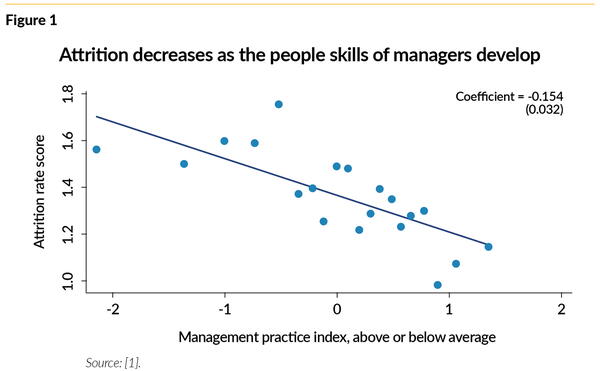
Premise
Local government does an abysmal job of firing poor performers. This failure directly and negatively impacts an organization’s effectiveness, efficiency, and productivity.
The Myth
There is a myth that it is impossible to fire a poor performer. Many mistakenly believe that the Supreme Court guaranteed employees the right to a public sector job. Absolutely not. In 1985, in Cleveland Board of Education v. Loudermill, the Supreme Court declared that government employees have a “property right” to their job and, as such, they have a right to due process. The right to due process is a far cry from a guaranteed job. It merely means that employees must have an appeal process so that they cannot be fired for political or discriminatory reasons, a manager’s bias or dislike, or a retaliatory act. It categorically does not mean that poor performers can’t be fired.
Firing an employee takes will and skill. By “will,” we mean the strength and courage to do the right thing despite resistance from unions, upper management, councils, or politics. By “skill,” we mean that a manager will surround herself or himself with informed advisors.
Stewart Liff, an author and fellow at The Performance Institute, said it best. “It all comes down to mind set. If you think you have the will and skill, then you can fire someone. If you buy into the stereotype that firing someone is too difficult, then you won’t.”
We are not suggesting that lots of your employees need to be fired. Based on our research and decades of experience, we estimate that 95% to 97% of your employees are high-quality, hardworking and dedicated employees; however, that leaves up to 5% of your workforce who are poor performers. This small group has a substantial negative impact on your organization.
Context Is Crucial
There is a significant difference in handling employee relations matters depending on your state. We have both spent our careers in California, which has strong unions, tough state rules, and often civil service or personnel commissions. We are writing this article from a California perspective.
Some of you are from “right to work” states and do not have unions or employee associations. This makes firing easier; however, all employers need to be cognizant of being sued for wrongful termination. Wrongful termination is any firing that violates a state or federal law, or public policy. State and federal laws prohibit employers from using discriminatory or retaliatory actions in firing an employee.
All states are governed by federal laws and the previously mentioned Supreme Court ruling. Your local requirements will guide how you proceed in the arena of employee relations.
Research Findings
Thorough research on this topic revealed data from the private sector and from the federal government, but no data on how local government handles poor performers. The results of our research are below:
• All studies agree that not dealing with poor performers will:
- Reduce the productivity of your organization.
- Lower the morale of your workforce.
- Negatively affect the retention of good employees.
- Reduce the quality of service of your organization.
• A McKinsey Study found that negative employee interactions by poor performers have five times the impact on an organization than positive employee interactions do.
• Based on the Office of Personnel Management and the Bureau of Labor Statistics, the private sector fires employees at about twice the rate as the federal government.
• When federal employees were asked how their agencies deal with poor performers who do not improve after receiving counseling, only 11% said their agency fired poor performers.
• We have personally observed the resistance and unwillingness of local government to fire poor performers and the negative impact of that failure to act on local government.
Why Doesn’t Local Government Fire Poor Performers?
To solve a problem, we must correctly define the causes of that problem. Why are supervisors and managers not firing poor performers? The research identifies the following reasons:
• It takes too much time and energy to fire an employee.
• One might lose the case and look bad.
• Dealing with poor performers is a low priority for most employers.
• Managers can’t bring themselves to have the “difficult conversation.” Telling someone their performance is unacceptable is hard.
• Many employers are fearful of being sued.
• A poor performer might be protected by someone higher up in the organization.
• Managers don’t get the proper support from their HR department or legal staff.
• Managers don’t understand the law, civil service regulations, or their own organization’s rules.
• Managers have never been trained on the disciplinary process.
• Some managers feel sorry for the person they know they should fire.
Many of these reasons are the result of fear, including fear of confrontation, losing, being sued, not being supported, or not being liked. Fear can paralyze people; however, good managers are not manipulated by their fears. Courage is facing one’s fear and doing the right thing.
Fears can be managed. First, support from the top to tackle poor performance is essential. Second, training on the disciplinary action process provides the knowledge needed to be successful. Third, having a great team of collaborative advisors to provide advice and counsel will increase the success rate and minimize not only the fear of failure, but the risk of failure.
Common Mistakes about Terminations
Managers and supervisors make some common mistakes that prevent them from acting on poor performance:
It is easier to ignore problem employees than to confront them. It may be easier in the short term, but in the long run, it takes more energy, requires more work, costs more money, and causes more harm.
Managers procrastinate, hoping the poor performer will change. Hope is not a strategy. Problems don’t solve themselves and become worse over time.
Managers hope the problem employee will leave on their own accord. Hope is also not a solution. Problem employees are comfortable in an organization that refuses to deal with them.
Managers deal with poor performers by reorganizing around them. The only person you are fooling is yourself. Everyone in the organization knows the reason for the reorganization and loses respect for the manager and organization.
Managers move the poor employee into a do-nothing job. Unfortunately, poor performers are a cancer in the organization, regardless of their position.
Sometimes the Manager Is the Poor Performer
Too often, we focus on employees and forget the greater damage a poor-performing manager or supervisor has on an organization. The research is clear: Poor-performing managers can devastate an organization. One study showed that when workers moved from a below-average boss to a high-quality boss their productivity increased as much as 50%. Figure 1 shows that turnover increases with poor management.

The Role of Human Resources and the City/County Attorney
The role of human resources and the legal department is to work closely and collaboratively with the department manager to assist that individual in dealing with employee conduct and performance issues, including the termination of poor performers. It is the role of all three stakeholders to work together to:
• Discuss thoroughly the performance and/or conduct issues of the employee.
• Identify and map out a strategy and process to undertake the appropriate actions for resolution.
Human resources and legal departments need to offer advice and assistance, not tell the department manager that an employee can’t be fired. The HR/legal team can identify the pitfalls of proceeding with an action, but some managers may want to proceed regardless. When an employee’s conduct is in direct conflict with an important organizational value, a manager may want to proceed with a termination, even when faced with the possibility of losing an appeal, in order to send a powerful message to the organization.
Unfortunately, human resources and legal departments are sometimes seen as impediments to firing a poor performer. They are often overly cautious and afraid of being sued. This causes managers not to act on problem employees.
If a small HR or legal department does not have the expertise to effectively assist department managers, the organization should retain a consultant who is an expert in employee relations and employment law to provide that assistance.
Ignore the Probationary Period at Your Own Risk
One of the most underutilized and easiest ways to get rid of a poor performer is to let them go during the probationary period, often the first 30 days to six months of their employment. This is often called the “final phase of the selection process.” Terminating someone during their probationary period takes less time and energy. Probationary employees have narrow access to appeal their rejection during probation.
Why are poor performers not let go during the probationary period? Research suggests that agencies:
• Have invested time and resources in the hiring process and don’t want to admit they made a mistake.
• Feel the pressure of vacancies and can’t face working shorthanded while they do another recruitment.
• Don’t understand the power of the probationary period and the importance of getting rid of problem employees at this stage.
If an employee is not performing well during the probationary period, then it is exceedingly unlikely they will improve as a regular employee. The probationary period is a gift to local government. Don’t waste it!
The Important Distinction between Misconduct and Poor Performance
Some employees have “conduct” issues, some have “performance” issues, and a few have both. Employees can be fired for either reason, but the process is somewhat different.
Misconduct: Misconduct cases are those where an employee fails to comply with work rules, policies, or procedures such as not arriving for work on time, not treating clients or coworkers with courtesy, being dishonest, not maintaining good attendance, and other similar behaviors. Such violations are dealt with through corrective action and progressive discipline, e.g., verbal or written warning, suspension, and ultimately dismissal.
Misconduct can also be more serious, including intentional, negligent, or illegal behavior such as lying, cheating, falsifying a resume, insubordination, stealing, or sabotage. One does not have to go through the progressive discipline process if the conduct is egregious. Moving directly to termination may be appropriate in such situations.
Poor Performance: Poor performance is the inability to get the job done to the employer’s expectations. The best way to deal with poor performers is using a performance improvement plan (PIP). A PIP allows the employee a chance to get the training and coaching necessary to improve and move to satisfactory performance. All PIPs must have at least three parts:
1. A clear description of what performance is subpar.
2. What the employee must do to improve her or his performance.
3. A specific statement of what training or other support the employee can expect to receive to improve.
Employees who are poor performers will sometimes have a history of positive performance evaluations. A history of positive evaluations can slow the process but does not prevent you from firing an employee. (This is a significant problem with performance evaluations and why in a previous article we recommended getting rid of such systems.)
Training and coaching can help a poor performer improve, but not an employee who has a serious misconduct issue.
Summary
The takeaways from this article are clear:
• Stop signing onto the myth that it is impossible to fire a poor performer.
• Poor performers cause low productivity, low morale, lower quality of service, and higher turnover.
• Firing poor performers requires will and skill.
• There are tons of excuses, but never good reasons for not dealing with poor performance.
• A very small percentage of your workforce are poor performers, but they cause a substantial negative impact.
• Don’t forget to fire poor-performing managers.
• HR and legal departments must provide advice and assistance to departments.
Poor performers who are not dealt with take up too much of an organization’s time, which should be devoted to encouraging and mentoring star performers. Hiring, developing, and firing employees are the most basic tasks of supervisors and managers. If you want to promote excellence in your organization, then you cannot tolerate poor performance

ED EVERETT, ICMA-CM (RETIRED), is a retired city manager (everetted@comcast.net).

MARY WELCH served as the human resources director for both San Mateo and Alameda counties in California for a total of 25 years. She also served as a human resources consultant for Management Partners for 10 years.
New, Reduced Membership Dues
A new, reduced dues rate is available for CAOs/ACAOs, along with additional discounts for those in smaller communities, has been implemented. Learn more and be sure to join or renew today!

